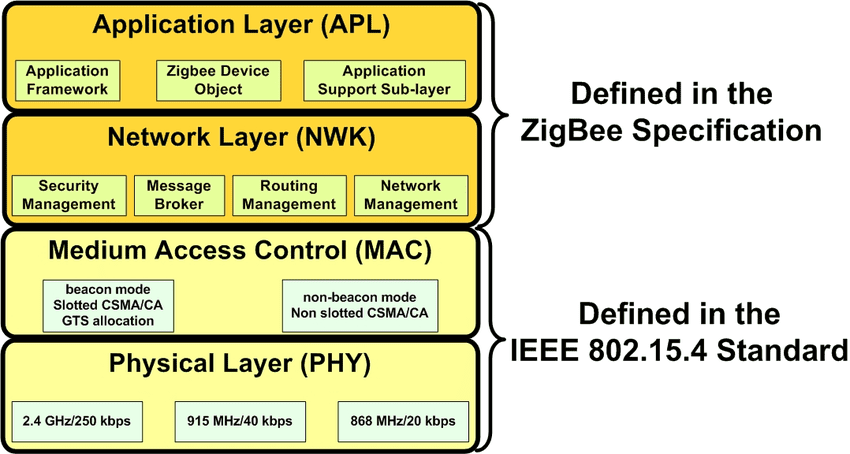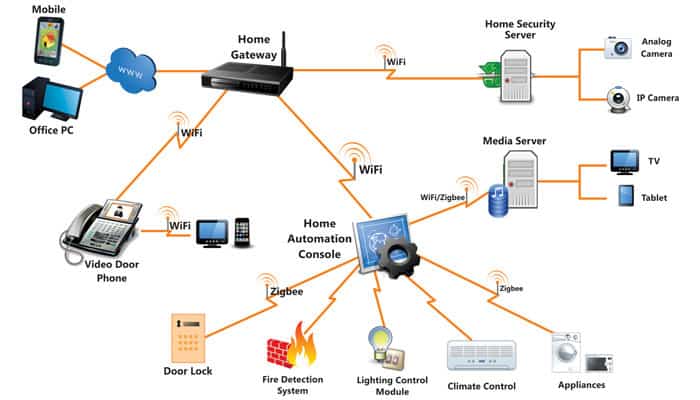What is ZigBee Technology and How it works? Electrical Technology
ZigBee Technology its Design, Architecture and Applications
Table of Contents
- Introduction to ZigBee Wireless Networking Technology
- History of ZigBee Technology
- ZigBee Architecture
- Network Topologies of ZigBee
- Communication using ZigBee
- Applications of ZigBee Technology
Introduction to ZigBee Wireless Networking Technology
ZigBee is a IEEE 802.15.4 based, low power, low data rate supporting wireless networking standard, which is basically used for two-way communication between sensors and control system. It is a short-range communication standard like Bluetooth and Wi-Fi, covering range of 10 to 100 meters. The difference being while Bluetooth and Wi-Fi are high data rate communications standard supporting transfer of complex structure like media, software etc.,
ZigBee Technology supports transfer of simple data like that from sensors. It supports low data rate of about 250 kbps. The operating frequencies are 868 MHz, 902 to 928 MHz and 2.4 GHz. ZigBee Technology is used mainly for applications requiring low power, low cost, low data rate and long battery life.
Also Read: Electric circuits / Networks and important terms related to it you must know
History of ZigBee Technology
ZigBee standard was developed by ZigBee Alliance including many major companies like Philips, Mitsubishi Electric, Epson, Atmel, Texas Instruments, etc. This Alliance was formed in 2002 as a non-profit organization.
ZigBee Architecture
The ZigBee Network Protocol follows IEEE 802.15.4 standards for Physical and MAC layers, along with its own Network and Application layers.
Figure 1: ZigBee Architecture
Also Read: An Overview of Energy Conservation in Buildings
Given below is explanation for each layer.
-
Physical Layer: This is the lowest protocol layer, and is responsible for controlling and activating the radio transceiver , and also for selecting the channel frequency and monitoring the channel. It is also responsible for communication with the radio devices. Communication of data or commands is done using Packets. Each PHY Packet consists of a Synchronization Header (SHR)(responsible for receiver synchronization), Physical Header (PHR)(contains information about Frame length) and PHY payload (provided by upper layers as a frame and includes data or command).
-
Medium Access Control or MAC Layer: It acts as an interface between the Physical layer and the Network layers. It is responsible for generation of Beacons and synchronization of devices in the Beacon enabled network. A MAC frame can be a Beacon Frame (used by Coordinator to transmit Beacons), Data Frame, Acknowledge Frame or a Command Frame. It consists of a MAC Header (contains information about security and addressing), Variable length size MAC Payload (contains data or command) and a MAC Footer (contains 16 bit Frame check sequence for data verification).
-
Network Layer: This layer connects the Application layer with the MAC layer. It manages the network formation and routing. It establishes a new network and selects the network topology. The NWK frame consists of the NWK Header and NWK Payload. The Header contains information regarding network level addressing and control. The NWK Payload contains the Application sublayer frame.
-
Application Support Sub Layer: It provides a set of services through two entities – Application SupportData Entity and Application Support Management Entity, to the application and network layers. These entities are accessed through their respective Service Access Points (SAP)
-
Application Layer: This is the highest layer in the network and is responsible for hosting the application objects which holds user applications and ZigBee Device Objects (ZDOs). A single ZigBee device can contain up to 240 application objects which control and manage the protocol layers. Each application object can consist of one application profile or program, developed by the user or the ZigBee alliance. The application profile is responsible for transmission and reception of data in the network. The type of devices and function of each device is defined in an application profile. The ZigBee Device Objects act as a interface between application objects, device profiles and the Application sub layer.
Network Topologies of ZigBee
ZigBee Network supports many types of topologies, the popular one being – star and peer to peer topologies. Each network topology consists of three types of nodes – ZigBee Coordinator, ZigBee Router and ZigBee End Device. The Coordinator performs the task of allocating unique address to each device in the network, initiates and transfers messages in the network and selects a unique identifier for the network. ZigBee devices are of two types –Full Function Device (FFD) and Reduced Function Device (RFD)
Figure 2: ZigBee Network Topologies
In a Star Topology, the Coordinator is the central device which initiates and manages devices within the network. Each coordinator selects a unique identifier, which is not used by any other network within its region of influence. Each End Device communicates with the Coordinator. The end devices are generally RFDs which can only communicate with the Coordinator or the FFD.
In Peer to Peer Topology, each end device can communicate with one another placed in its vicinity. The devices are FFDs which can communicate directly with each other. However, this type of topology can contain a RFD which communicates with only one device in the network. A Peer to Peer Topology can be a Mesh topology or a Tree Topology.
Also Read: Automatic UPS system wiring circuit diagram (New Design Very simple) for Home or Office
Communication using
ZigBee
Transfer of data can be between a Coordinator and Device or Peer to Peer. Data Transfer between Coordinator and Device can be done using two methods – Beacon Enabled and Non Beacon Enabled.
In Beacon Enabled Networking, contention free channel access method is used. Here the Coordinator allocates a particular time slot to each device, known as Guaranteed Time Slot (GTS). Here all the devices in the network need to be synchronized. This is ensured by sending a Beacon signal from the coordinator to each device (node), such that each device synchronizes its clock. However, this may end up reducing the battery life of devices when not in any other task than synchronizing their clock.
Once the device is synchronized, it can transmit data to the coordinator using Carrier Sense Multiple Access with Collision Avoidance (CSMA-CA) method, wherein type of occupying signal is determined, or during the GTS allocation period. On sending a request, the Coordinator sends back the acknowledgement. For transfer of data from Coordinator to device, an indication is send with the Beacon message to the device. The device then receives this indication and sends a data request message. The Coordinator sends an acknowledgment of this data request receipt and transfers the corresponding data.
In Non-Beacon Networking, the Coordinator does not transmit any Beacon message. Rather, each device transmits data using CSMA-CA method in the same frequency channel. The device transmits the data as soon as the channel is clear. For transfer of data from Coordinator to device, the device first sends a data request message to the Coordinator and then the latter transmits the data message with a null length payload, on availability of data. For no pending data, the Coordinator sends an acknowledgement indicating no data pending.
Also Read: What are Industrial Communication Networks? An Overview
Applications
of ZigBee Technology
Home Automation: ZigBee technology proves to be the most reliable technology in realizing home automation. Different applications like controlling and monitoring energy consumption, water management, light control etc. have been made easier through automation using ZigBee technology.
Figure 3: ZigBee Home Automation
Industrial Automation: ZigBee based RFID devices help provide reliable access management in industries. Other applications in industries include process control, energy management, personnel tracking etc.
Healthcare Automation: A popular example of healthcare automation is remote health monitoring. A person wears a ZigBee device with a body parameter measuring sensor which collects the health information. This information is transmitting on the ZigBee network to the Internet Protocol (IP) network and then to the Healthcare personnel (the physician or the nurse), who would then prescribe proper medication based on the received information.
You may also read: Power Distribution in Industries – All You Need to Know
Apart from the above three, there are many applications of ZigBee technology. This is a brief introduction about ZigBee technology. Any other information regarding this technology is welcome in the below comments section.
Also read:
URL Copied















![Toni Kroos là ai? [ sự thật về tiểu sử đầy đủ Toni Kroos ]](https://evbn.org/wp-content/uploads/New-Project-6635-1671934592.jpg)


